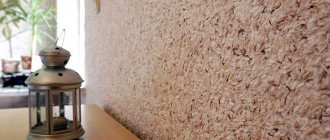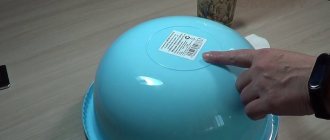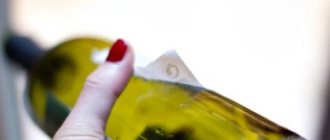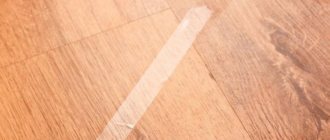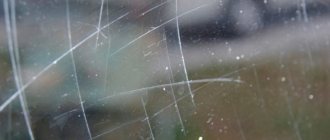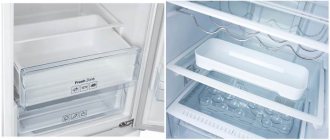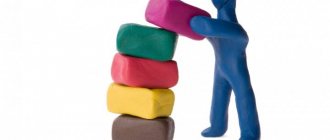Once I came to visit my distant relative. I look and all the plates and cups have labels on the bottom. I was very surprised by this fact, and a relative complained that it was impossible to remove the sticker from the dishes. It cannot be touched by nails, and tearing it off with something sharp is not an option. Scratches may remain. Without thinking twice, I told her several ways. My favorite is with a hairdryer.
Hairdryer vs stickers on plates
Why is this method your favorite? It's simple. The stickers fly off the dishes themselves in a matter of seconds. There is no need to rub, pry, or scratch anything. No stink from fusion fluids. Which, by the way, harm the skin of your hands and can “eat” the colorful design on the dishes. And another five minutes is enough to clean a large set of dishes.
To remove the sticker I do the following:
- I turn on the regular hair dryer I use to dry my hair at maximum temperature and speed.
- I bring it almost close to the sticker.
- I blow it for 15-20 seconds.
Usually this time is enough for the label to fly off. Be prepared to catch her. Otherwise, it will be blown away by a stream of air from a hairdryer, and you will have to look under the tables. In my opinion, this method would be ideal. If it were not for one “but” - if the dishes are of high quality and expensive, then the labels will stick very tightly. Apparently they use some kind of super glue. Then you have to resort to other tricks.
Window cleaner
If the sticker is on glassware, it is logical to use glass (window) cleaning products. I've been cleaning pink Mister Muscle windows for years now. When new plastic windows were installed, I tried spraying it on the branded sticker. And it came off quite easily. Then I tried it on glass cups. And again the result is positive. The main thing is that the product is for glass, which means the glassware will not be damaged.
What do we have to do:
- Pry up the edge of the sticker (just a little).
- Spray a little dishwashing detergent onto the label.
- Wait 2-5 minutes.
- Wipe off the sticker with a cloth.
All it takes is a few movements back and forth. The paper rolls up along with the glue. If anything remains, I apply the window cleaner again. I don't think it's necessary to use Mr. Muscle. The composition of glass cleaners is the same, plus or minus.
Nail polish remover
I still remember the times when nail polish was removed with acetone, a strong solvent. Today there is some other composition in the jars. The liquid hardly smells, and it seems to me that it dissolves the varnish worse. I myself do not use these products; I have been applying gel polish for many years. But the jars remained standing at home. One of them with that same smelly liquid with acetone. “Marigold” is called, with a blue label. This is what we need.
We recommend: How to test water hardness - convenient and quick methods
Nail polish remover can remove stickers from dishes without leaving any traces. But it can only be used on glass and ceramics without a pattern. It can ruin plastic and paints.
To remove stickers from glass (ceramics):
- Soak a cotton pad in nail polish remover.
- Place it on top of the sticker.
- We wait a few minutes (1-2 minutes is enough).
- Easy for three.
- The label is destroyed and remains on the cotton wool.
This is the surest remedy against stickers. They can also remove any remaining glue. For example, if a piece of paper was unsuccessfully torn off and traces remained under it.
How to remove glue with Dimexide?
To remove super glue from laminate or any other material: plastic, metal, linoleum or soft things (the product is very gentle on any type of surface), moisten a cotton pad with dimexide and, using smooth, rubbing movements, wipe the super glue from the surface.
Interesting materials:
How to link an intersection map to an iPhone? How to link a Tinkoff card to tanks? How to link a card in the telecard application? How to link a new Perekrestok card to your phone? How to link a social card to a pass? How do they check card payments on the bus? How does the Letual Diamond Card work? How does the Adidas Universe card work? How does the Rosneft loyalty card work? How does the card work on an iPhone?
Essential oils
My favorites are cedarwood and orange essential oils. I love these smells since childhood. I turn on the aroma lamp, and I don’t even need a cup of coffee to cheer me up. Meanwhile, essential oils not only tone and uplift, but also dissolve glue residues well. If you want to remove the label from your dishes and have fun at the same time, this method is ideal.
Dishes are cleaned quickly and easily:
- Turn the plates (saucers, cups) upside down.
- Add 1-2 drops of oil to the area to be cleaned.
- Leave for 10 minutes.
- The glue becomes soft. All that remains is to wipe it with a napkin.
If the label on the dish is intact, this method will not help much. You need to peel it off if possible, and then use essential oil to remove traces of glue.
How to wipe dry?
In a situation where super glue has left a mark on clothing for a long time, washing with powder or washing with laundry soap will be ineffective. Special compounds that can dissolve dried Moment will come to the rescue.
The structure of frozen super glue is destroyed by acetone-containing agents, alcohol, and a solvent based on dimethyl sulfoxide - pharmaceutical dimexide.
By acting on cynoacrylates, these products soften the dried stain. No less effective is an approach such as exposure to low (freezing) and high (iron) temperatures.
If the first application fails to remove traces of glue using home methods, you can try again, but using special preparations.
Amway lifesaver
I used to be skeptical about Amway. Until I developed an allergy to regular mass-market detergents. The palms were terribly itchy and covered with purple-red flaky spots. Creepy. The boss, seeing my hands, advised me to try dishwashing detergent from Amway DISH DROPS home. It seemed expensive to me, but I didn’t really have to choose. At first I was disappointed with the purchase. When the concentrate is diluted, it turns out to be a very liquid product with a pungent odor.
It's funny to me now. After just a couple of days, I completely changed my opinion about him. I dilute the concentrate 1 to 9 with water in a spray gun. 5 sprays in a bowl with a little warm water, and wash a whole mountain of dishes. After washing, there is no residue or film left, the dishes literally shine. There is no smell left either, and no streaks either. And most importantly, my hands are fine. And all the dirt is washed off with a bang, even if the dishes stood in the sink all night.
What I mean is that the Amway product can easily wash off not only food residues, but also stickers on new dishes. And not only on glass and ceramic, but also on plastic. When using it, you don’t have to worry about the paint fading. This is how I remove stickers:
- I fill a wide bowl with warm water.
- I spray Amway product into the water (4-5 sprays).
- I place the dishes in the bowl for 3-5 minutes.
- I wash the labels along with the glue using a sponge and the same soap solution.
- I rinse it off.
We recommend: Diseases in your home: how to prevent mold?
Once I tried to remove the sticker using Amway home SA8 stain remover spray. He did even better. The sticker and glue instantly softened and were easily wiped off with a napkin. But this is a last resort. After all, the stain remover is intended for clothing, not dishes from which you eat.
Mirrors
- face lotions;
- salicylic acid (can be purchased at a pharmacy);
- toilet water;
- regular vodka;
- cleaning products (for example, glass washing liquid);
- deodorants and body sprays;
- wet wipes.
The sticky layer from stickers and tape from plastic can be easily removed with alcohol. If there is no alcohol, then you can try to remove this sticky stain with any alcohol-containing solution - cologne, vodka, lotion, or white spirit. However, first test your chosen solvent in an inconspicuous place. You need to determine whether the solvent you choose will damage the surface of the device.
My Husband's Ways
My husband and I have radically different opinions about various modern innovations. He thinks that all these jars and bottles are a whim. He says why reinvent the wheel if you can use traditional methods. Can:
- Wipe off the sticker from the dishes with vegetable oil. You drip it, rub it with a cloth, and it rolls into a lump.
- Dissolve the label and remaining glue with white spirit. I applied a cotton wool soaked in white spirit where needed, waited a couple of seconds and rubbed.
The methods really work. My husband demonstrated. So it may well be useful to someone. But I really don’t like the smell of white spirit, and instead of vegetable oil, I’d rather take essential oil. And also, if the set is expensive, like Luminark, using rustic methods is somehow out of hand. This is my personal opinion.
Universal WD-40
Another option suggested by my husband. But this time our views converged. This product is one of the most frequently used in our home. It helps lubricate door hinges, helps clean shoes, and performs a bunch of other functions.
For those who don't know, WD-40 is a very slippery lubricant. Despite the fact that it glides well, it does not leave greasy marks. The product, on the contrary, is used to remove grease, as well as rust, glue and various stains.
Cleaning dishes from WD-40 stickers is very simple:
- Spray a little product onto the edge of the label (glue spot).
- We move it to the side with something flat and not sharp (for example, a plastic card or a stack of plasticine).
The paper and glue are removed due to good sliding. 30 seconds is enough to clear everything.
It also happens that the sticker is based on your word of honor. This is immediately obvious. It seems like it costs nothing to peel it off by hand. But no. The top paper layer peels off, leaving traces of glue on the dishes. You have to go get nail polish remover or something like that. Therefore, I don’t take risks, and in such cases I always wet the labels with cold water. Hot water will cause paper to fall apart. And in the cold, not very high-quality glue ceases to be so sticky. A couple of minutes in the water, one movement and the flimsy label is removed. How do you remove stickers from dishes?
Features of removal depending on the type of sticker
Stickers applied to household appliances differ in the material they are made of. The method of cleansing largely depends on this. The only common methods for removing traces of glue that remain after removing the picture itself are:
- Paper labels. They are able to absorb water, so they are cleaned after soaking with any liquid (water, soap solution, alcohol). You can scrape off the paper with a sponge, wooden or plastic spatula.
- Polymer and laminated labels. The top layer is removed manually. The corner of the sticker is pryed up and, by pulling it, the entire sticker is peeled off. You can make this process easier by heating with a hairdryer. The heat melts the adhesive and the label comes off effortlessly.
- Old stickers. Their removal depends on the quality of the base: paper and polymer require their own methods. Cleaning is complicated by the fact that over time the glue hardens and for soaking it is necessary to increase the exposure time.
